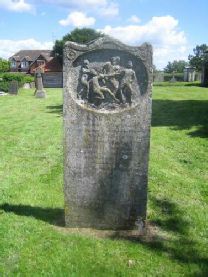



The Parish Church of St George the Martyr, Waterlooville

Thursley, Surrey
Just north of the newly constructed Hindhead Tunnel lies the pretty village of Thursley.
In the churchyard there I discovered an unusual gravestone describing the grisly 18th century murder of an unknown sailor. On September 24 1786 this sailor was walking from London to join his ship in Portsmouth. He stopped for refreshment at the Red Lion Inn in Thursley where he met three other seafarers, James Marshall, Michael Casey and Edward Lonegon. He treated them all to drinks and food before they all left together to walk over Hindhead Hill en route to Portsmouth. There the three men attacked and killed the unfortunate sailor stealing all his money and stripping off all his clothes before fleeing the scene. A day or so later they arrived at the Sun Inn in Rake. Suspicions were aroused when they foolishly tried to sell the sailor’s clothes as news of the murder had already reached Rake. The constable was informed and they were arrested. Six months later they were tried for murder at Kingston Assizes and convicted. Two days later on 7 April 1787 they were taken to the scene of the crime and hanged in chains on a triple gibbet as a warning to others.
The poor sailor was buried in Thursley churchyard. His grave stone is headed by a carved depiction of the murder and inscribed as follows:
In Memory of a Generous but unfortunate Sailor who was barbarously murdered at Hindhead on Sept 24 1786 by three Villains after he had liberally treated them and promised them further assistance on the road to Portsmouth.
When pitying Eyes to see my grave shall come
And with a generous tear bedew my tomb
Here shall they read my melancholy Fate.
In perfect Health and in flower of Age
Fell victim to three Ruffians Rage,
On bended knees I mercy strove to obtain.
Their thrift and Blood made all Entreaties vain.
No dear relation or still dearer Friend
Weeps my hard lot or miserable End
Yet o’er my sad Remains (my name unknown)
A generous Public have inscribed this Stone.
A second memorial can also be seen on the hill near the murder scene. This was erected by James Stillwell of nearby Cosford Mill. It is inscribed
ERECTED
In detestation of a barbarous Murder
Committed here on an unknown Sailor
On Sep 24th 1786
By Edwd Lonegon, Mich Casey & Jas Marshall
Who were all taken the same day
And hung in chains near this place.
Whoso sheddeth Man’s Blood by Man shall his Blood be shed. Gen Chap 9 Ver 6
80 years later (in 1851) Sir William Erle erected an imposing granite Celtic Cross on Gibbet Hill on the site of the scaffold, supposedly to dispel the fears and superstitions of local people and to raise their spirits. There are four Latin inscriptions around its base.
POST TENEBRAS LUX
IN OBITU PAX
IN LUCE SPES
POST OBITUM SALUS
“Light after darkness. Peace in passing away. Hope in light. Salvation after death.”
Apparently the murder is mentioned by Charles Dickens in his novel Nicholas Nickleby (chapter 22) when Nicholas and Smike walk round the rim of the Devil’s Punch Bowl and read the inscription on the memorial. “The grass on which they stood had once been dyed with gore, and the blood of the murdered man had run down, drop by drop, into the hollow which gives the place its name. ‘The DEVIL’S BOWL’ thought Nicholas, as he looked into the void ‘never held fitter liquor than that.”
John Symonds
Winter Edition 2012
The Unknown Sailor’s Memorial
